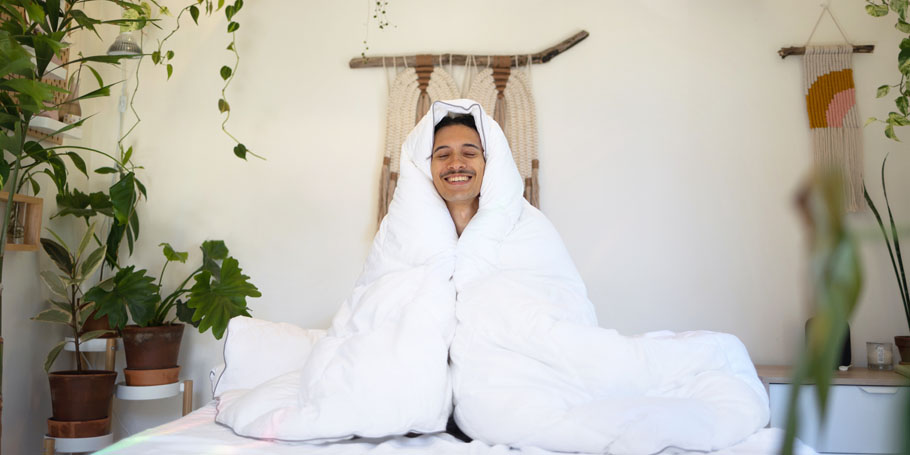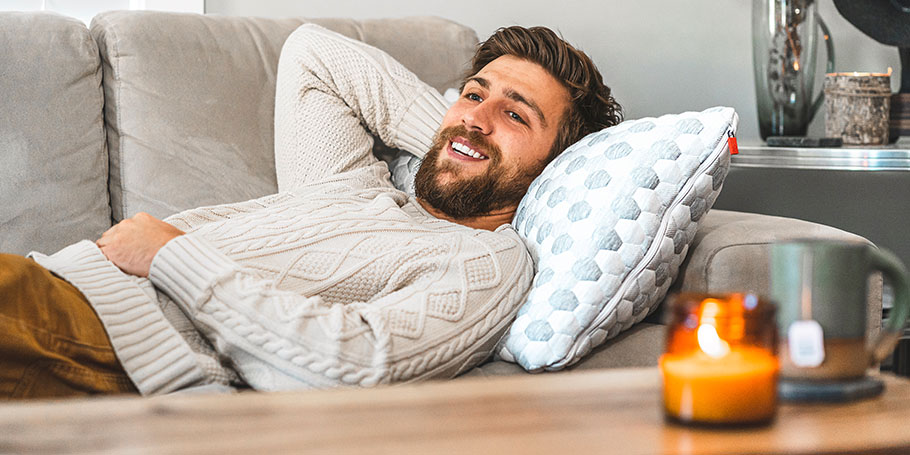In this guide, we’ll go over suitable winter garments your baby can wear to sleep and teach you how to use the TOG Rating to assess the warmth of certain garments. We’ll also discuss the importance of keeping a comfortable sleeping environment and suitable room temperature to minimize overheating. Read on to learn how to dress your baby for sleep in winter, or use the links below to get started.
- What Should Babies Wear to Bed in the Winter?
- What Is the Ideal Bedroom Temperature for Babies in the Winter?
- How to Create a Comfortable Sleeping Environment for My Baby
- Wrapping Up: How to Dress Your Baby for Sleep in Winter
What Should Babies Wear to Bed in the Winter?
During the winter, it’s easy to over bundle your baby with thick onesies and blankets. So, how to dress a baby for sleep in winter without going overboard? Here are a few garments that babies can wear to sleep in the winter:
- Swaddle: Swaddles are blankets that mimic the warmth of a mother’s womb and keep your baby nice and wrapped.
- Long sleeve layer: A basic long sleeve can provide warmth and comfort without causing your baby to overheat. These are typically layered with singlets, bodysuits, and onesies.
- Singlets: Singlets are one-piece garments that are typically sleeveless.
- Bodysuits: A baby bodysuit is another type of one-piece garment that resembles a leotard and exposes the legs.
- Onesie: Onesies are loose-fitting garments that extend beyond the waist and include a snap for easy diaper access at the crotch.
- Sleepsack: A wearable blanket that can keep your baby warm. Since it’s worn by your baby, they won’t be able to kick it off themselves.
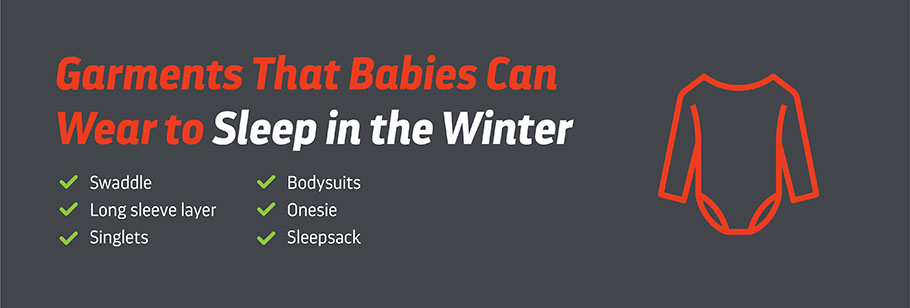
Even though the temperature outside is dropping, babies usually don’t need that many layers. In fact, too many layers can cause your baby’s internal temperature to rise to dangerous levels. If you’re having difficulty finding a suitable garment for your baby as the seasons change, the TOG Rating can help you.
What Is a TOG Rating?
The TOG (Thermal Overall Grade) Rating is a unit of measurement that tells you how warm an article of clothing is. The scale ranges from .1 to 3.5, with .1 TOG being the least warm and 3.5 TOG the warmest. So, the higher the TOG, the better it is for frigid weather conditions. TOG ratings are valuable for parents because it can help them pick the safest clothing for their baby to sleep in and minimize the risk of overheating.
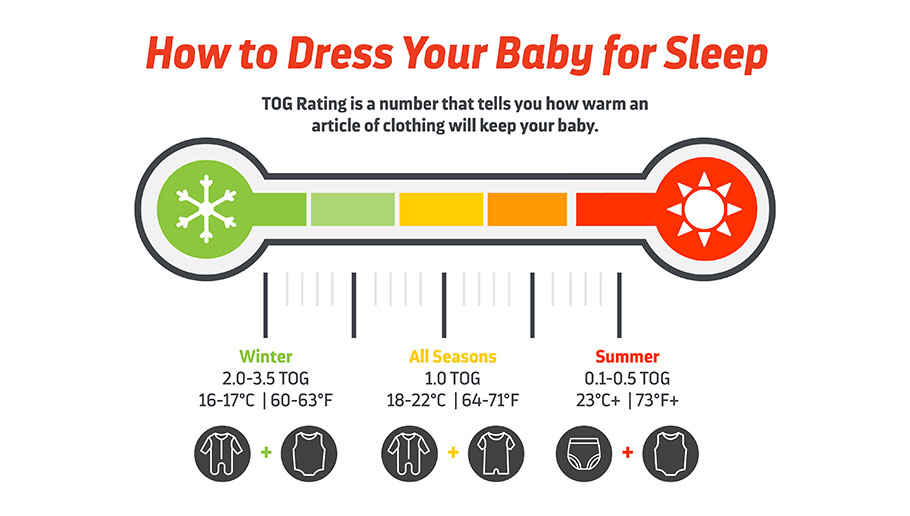
Keep in mind that the TOG rating should be used as a general guideline for your baby’s sleepwear. Make sure to keep a close eye on your baby as they sleep.
What Is the Ideal Bedroom Temperature for Babies in the Winter?
Part of learning how to dress a baby for bed in winter is knowing the ideal room temperature for them to sleep in. A baby will sleep comfortably in a bedroom that’s between 68 to 72 degrees Fahrenheit, as long as they’re dressed properly. The temperature of a room has a major impact on the quality of sleep your baby receives. This is because the temperature can affect their circadian rhythm, making it more difficult to fall asleep when they’re too hot or cold.
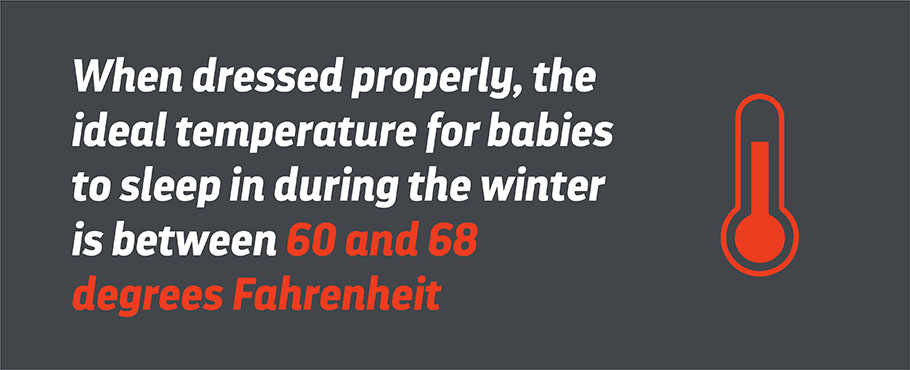
It’s important to keep the baby’s room within the best temperature for sleep range to reduce the likelihood of sudden infant death syndrome (SIDS). This is particularly important to note during the colder months when infants are most at risk for SIDS. Winter can be a dangerous time for babies, as parents or caregivers can overdress them in layers of blankets and clothes to combat frigid weather.
If your baby has nasal congestion at night or other symptoms of a cold it may be tempting to raise their room’s temperature and wrap them up in layers of clothing. However, this can easily cause them to overheat, especially if they have a fever. To prevent overheating, keep the bedroom at a comfortable temperature and dress your baby in an appropriate garment for the current temperature.
Babies can’t communicate when they’re too hot or cold, so it’s up to you to be on the lookout. Below, we’ve outlined a few ways that you can check your baby’s temperature to ensure they’re neither too hot nor cold.
How Can I Tell if My Baby Is Too Hot?
While your baby may not be able to verbally tell you they’re hot, there are several indicators that can let you know. This includes skin that’s warm or hot to the touch, visible perspiration, damp hair, and flushed cheeks. As mentioned, an increase in body temperature can put your baby at risk for SIDS. Here are a few additional signs and symptoms that can signal overheating:
- Rapid heartbeat
- Lethargy
- Vomiting
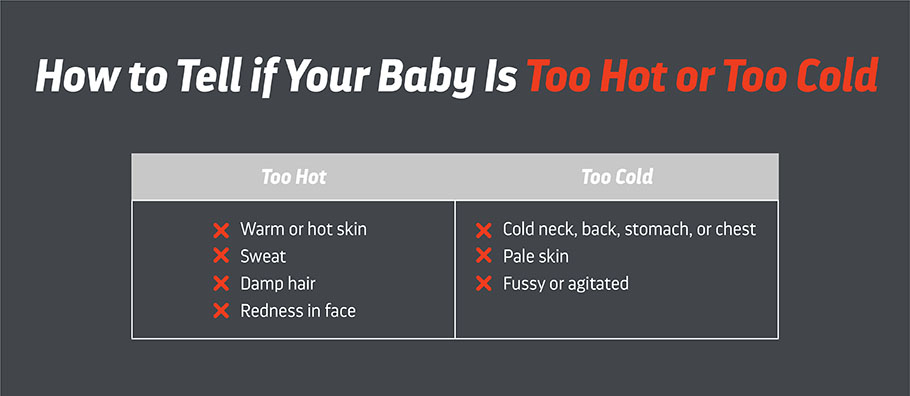
How Can I Tell if My Baby Is Too Cold?
To check if your baby is too cold, you can gently feel their nose, back, stomach, back of the neck, and chest. If your baby’s skin feels cold, it’s time to add an additional layer of clothing or adjust the room temperature slightly. When adding layers, make sure to go slowly. Adding multiple layers at once can warm up your baby too quickly and lead to overheating.
Note that it’s normal for your baby’s hands and feet to be cold sometimes. However, if other areas are frigid, your baby is being fussy, or they’re showing other signs of discomfort, it’s best to investigate and see if the cold temperature is the problem.
How to Create a Comfortable Sleeping Environment for My Baby
In addition to knowing how to dress your infant for sleep in winter and setting the room to an ideal temperature, learning how to create a comfortable and safe sleeping environment is vital. After all, a safe sleep environment can boost the quality of their sleep, which is essential for their overall physical and emotional development. Some ways you can make your baby’s bedroom as comfortable and safe as possible include:
- Using fitted sheets: A tight-fitting sheet will stay on your baby’s bed despite movement, minimizing the risk of suffocation. When searching for bed sheets, consider bamboo sheets that are thermoregulating to help your baby stay at a cozy temperature.
- Keeping the crib empty: Loose and soft objects in a crib can increase the likelihood of suffocation or harm. Keep the crib clear of blankets, pillows, quilts, toys, and similar products.
- Sharing a room: The American Academy of Pediatrics recommends parents sleep in the same room as their baby to keep a close eye on them. However, avoid sleeping in the same bed, as you can accidentally roll over them.
- Monitoring the thermostat: During the winter, it’s easy to crank the heater all the way up. But, babies will be comfortable in cooler temperatures between 68 to 72 degrees Fahrenheit. Monitor your thermostat to ensure the temperature stays within this range.
- Avoiding thick comforters: Thick comforters can raise the temperature of your baby, so it’s best to avoid them altogether. Once your child is of age and the risk of SIDS has lessened, use our comforter buying guide to help you find the best one for them.
- Providing a firm sleeping surface: A firm mattress can provide your baby with enough support to receive a good night’s rest. Waterbeds, old mattresses, and sofas may be too soft to support their body and can increase the chance of suffocation.
Keep in mind that every baby is different, and what may work for one child may not work for another. That said, finding the right winter clothing and room temperature and creating a suitable sleeping environment may take some trial and error.
Wrapping Up: How to Dress Your Baby for Sleep in Winter
During the winter, the risk of sudden infant death syndrome significantly increases due to overheating from extra layers of clothing and blankets. This is why it’s essential to learn how to dress your baby at night in winter. One way to ensure your baby is appropriately dressed for sleep in winter is by using the TOG Rating as a guide to purchasing onesies, bodysuits, and sleepsacks. These articles of clothing are safe for your baby to sleep in when the temperature drops.
While the TOG Rating should only be used as a reference point, it can help you gauge whether certain garments are appropriate for the current temperature. Other ways to provide your baby with a good night’s rest in winter include keeping the room between 68 to 72 degrees Fahrenheit and assessing their body to verify they’re not too cold or warm.


